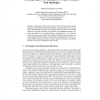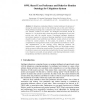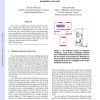252 search results - page 23 / 51 » Using OWL to model biological knowledge |
SEMWEB
2005
Springer
14 years 1 months ago
2005
Springer
Information retrieval systems have to deal with uncertain knowledge and query results should reflect this uncertainty in some manner. However, Semantic Web ontologies are based on...
KCAP
2009
ACM
14 years 2 months ago
2009
ACM
Curating information from the literature for storage in databases is a crucial task in biological research, and many groups assign a particular person or team to that process. We ...
ICDE
2006
IEEE
14 years 1 months ago
2006
IEEE
This paper presents a description of seven systems, which use database technology to both represent knowledge persistently and make scalable queries on it, in the Semantic Web con...
OTM
2005
Springer
14 years 1 months ago
2005
Springer
In ubiquitous computing, behavior routine learning is the process of mining the context-aware data to find interesting rules on the user’s behavior, while preference learning tri...
IV
2008
IEEE
14 years 1 months ago
2008
IEEE
This article is addressing a recurrent problem in biology: mining newly built large scale networks. Our approach consists in comparing these new networks to well known ones. The v...



